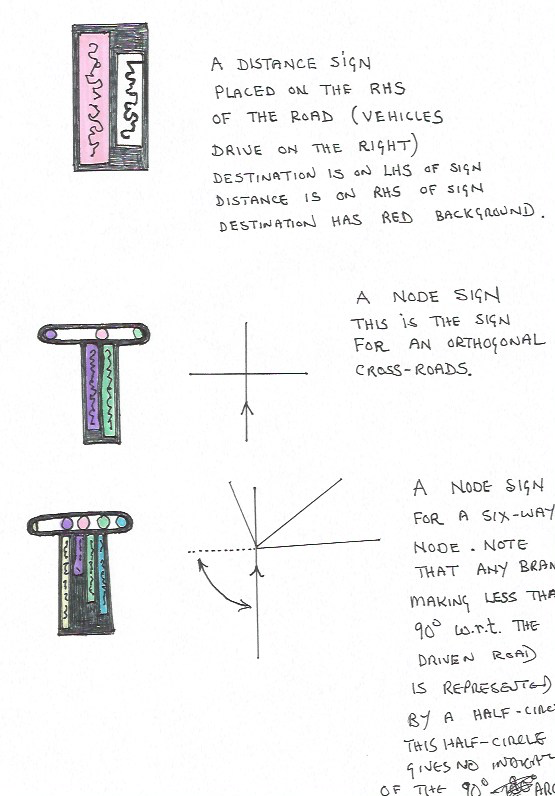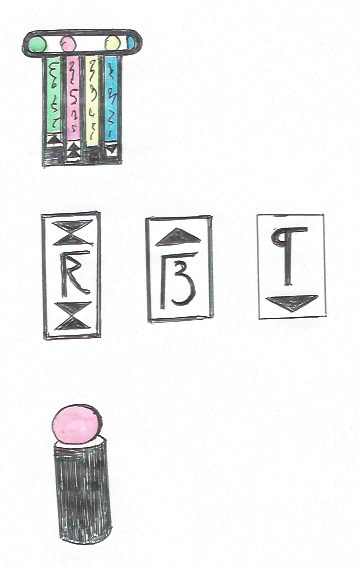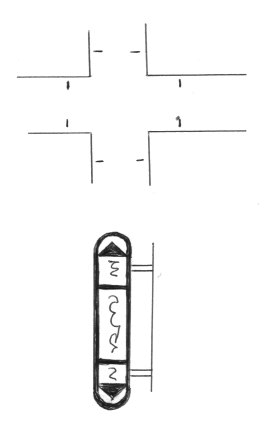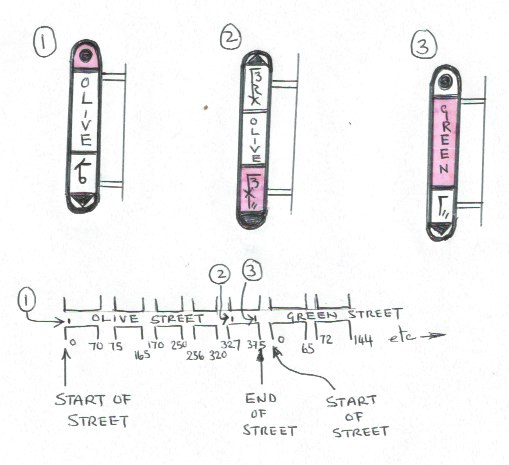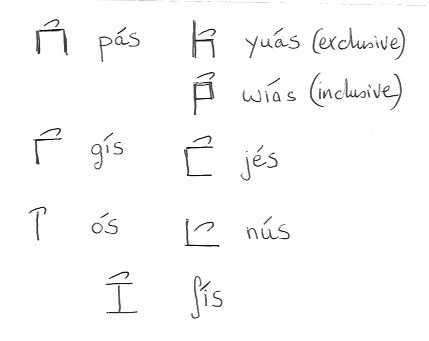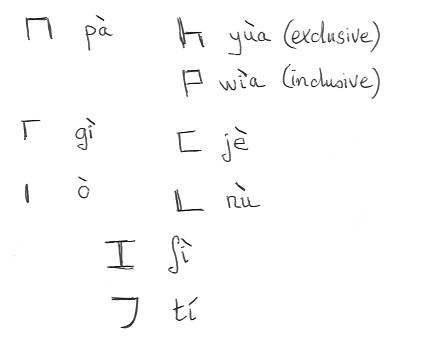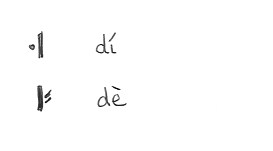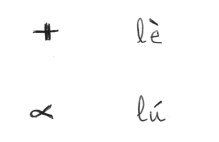Béu : Chapter 4 : The Adjective: Difference between revisions
| Line 613: | Line 613: | ||
3) One of the functions of a nouns with '''pilana''' 1 => 8 + 15 is as an adverb. This type of adverb must follow the verb immediately. In a similar manner to type 2), if this form comes after a noun it is considered an adjective. For example ... | 3) One of the functions of a nouns with '''pilana''' 1 => 8 + 15 is as an adverb. This type of adverb must follow the verb immediately. In a similar manner to type 2), if this form comes after a noun it is considered an adjective. For example ... | ||
'''moŋgos flora ama mezlimau | '''moŋgos flora ama mezlimau''' (the gibbon is eating an apple on the apple) '''mezlimau''' is an adjective describing where the apple is (or was). | ||
'''moŋgos flora mezlimau ama''' (the gibbon is eating an apple on the apple) '''mezlimau''' is an adverb describing where the "eating" is taking place. | '''moŋgos flora mezlimau ama''' (the gibbon is eating an apple on the apple) '''mezlimau''' is an adverb describing where the "eating" is taking place. | ||
Revision as of 04:06, 2 March 2015
..... 72 Adjectives
..... 4 of which serve as intransitive verbs
..
| bòi * | good | boizora | she is healthy | bòis | to be healthy/health |
| kéu | bad | keuzora | he is ill | kéus | to be sick/illness |
| fái | rich ** | faizora | she is interested | fáis | to be attentive/attention |
| pàu | bland | pauzora | he is bored | pàus | to be bored/boredom |
* Note that the adverb version of this word is slightly irregular. Instead of boiwe it is bowe. People often shout this when impressed with some athletic feat or sentiment voiced ... bowe bowe => well done => bravo bravo
Also instead of keuwe we have kewe. People often shout kewe kewe kewe if they are unimpressed with some athletic feat or disagree with a sentiment expressed. Equivalent to "Booo boo".
**In a non-monetary sense. If applied to food it means many flavours and/or textures. If applied to music it means there is polyphony. If applied to physical design it means baroque.
..
... 12 of which don't serve as any type of verbs
..
| igwa | equal, the same |
| uʒya | different, not the same |
| sài | young |
| gáu | old (of a living thing) |
| jini | clever, smart |
| tumu | stupid, thick |
| wenfo | new |
| yompe | old, former, previous |
| cùa | east, dawn, sunrise |
| día | west, dusk, sundown |
| bene | right, positive |
| komo | left, negative |
..
(Of course you can always use a periphrastic expression if you wanted.)
... 54 of which serve as transitive verbs
..
| boʒi | better | kegu | worse | bozor | he/she improves | kegor | he/she made something worse | boʒido | to improve | kegudo | to made worse |
| faizai | richer | paugau | blander | faizor | she developed | paugau | she run something down | faizaido | to enrich/develope | paugaudo | to run down |
| maze | open | nago | closed | mazori | he opens | nagori | he closes | mazedo | to open | nagodo | to shut |
| saco | fast | gade | slow | sacori | she speeds up | gadori | she slows down | sacodo | to accelerate | gadedo | to decelerate |
| fazeu | empty | pagoi | full | fazor | he empties | pagor | he fills | fazedo | to empty | pagodo | to fill |
| hauʔe | beautiful | ʔaiho | ugly | hauʔor | she beautifies | ʔaihor | she makes ugly | hauʔedo | beautify | ʔaihodo | to make ugly |
| ailia | neat | aulua | untidy | ailor | he tidies up | aulor | he messes up | ailido | to tidy up | auludo | to mess up |
| joga | wide | teza | narrow | jogor | he widens | tezor | he narrows | jogado | to broaden | tezado | to narrow |
| ái | white | àu | black | aidor | he whitened | audor | he turned something black | aido | to whiten | audo | to blacken |
| hái | high | ʔàu | low | haidor | she raised | ʔaudor | she lowered | haido | to raise | ʔaudo | to lower |
| guboi | deep | sikeu | shallow | gubodor | she deepens | sikedor | she makes shallow | gubodo | to deepen | sikedo | to make shallow |
| seltia | bright | goljua | dim | seltidor | he brightens | goljudor | he dims | seltido | to brighten | goljudo | to dim |
| taiti | tight | jauju | loose | taitidor | she tightens | jaujudor | she loosens | taitido | to tighten | jaujudo | to loosen |
| jutu | big | tiji | small | jutudor | he expands | tijidor | he shrinks | jutudo | to enlarge | tijido | to shrink |
| felgi | hot | polzu | cold | felgidor | she heats up | polzudor | she cools down | felgido | to heat up | polzudo | to cool down |
| baga | simple | kaza | complex | bagador | she simplifies | kazador | she complicates | bagado | simplify | kazado | to complicate |
| naike | sharp | maubo | blunt | naikedor | he sharpens | maubodor | he blunts something | naikedo | to sharpen | maubodo | to blunt |
| nucoi | wet | mideu | dry | nucodor | she makes wet | midedor | she dries | nucodo | to make wet | midedo | to dry |
| wobua | heavy | yekia | light | wobudor | he loads up | yekidor | he unloads | wobudo | to load up | yekido | to unload |
| pujia | thin | fitua | thick | pujidor | he makes thin | fitudor | he thickens | pujido | to make thin | fitudo | to thicken |
| yubau | strong | wikai | weak | yubador | she strengthens | wikador | she weakens | yubado | to strengthen | wikado | to weaken |
| fuje | soft | pito | hard | fujedor | softens | pitodor | she hardens | fujedo | to soften | pitodo | to harden |
| gelbu | rough | solki | smooth | gelbudor | she roughens | solkidor | she smoothes | gelbudo | to roughen | solkido | to smooth |
| ʔoica | clear | heuda | hazy | ʔoicador | she explains | heudador | she confuses | ʔoicado | to explain | heudado | to muddy the waters |
| selce | sparce | goldo | dense | selcedor | he prunes | goldodor | he intensifies | selcedo | to prune | goldodo | to intensify |
| cadai | fragrant | dacau | stinking | cadador | she make fragrant | dacador | she makes stinky | cadado | to make fragrant | dacado | to make stinky |
| detia | elegant | cojua | crude | detidor | he decorates/embellishes | cojudor | he spoils | detido | to decorate | cojudo | to decorate in a gauche style |
..
The top 4 adjectives in the table above are actually irregular comparatives.
The standard method for forming the comparative and superlative is ... ái = white : aige = whiter : aimo = whitest
..
However not quite all antonyms fall into the above pattern. For example ...
loŋga = tall, tìa = short
wazbia = far, mùa = near ... wazbo = distance, wazbai = about 3,680 mtr (the unit of distance)
..
... Antonym phonetic correspondence
..
In the above lists, it can be seen that each pair of adjectives have pretty much the exact opposite meaning from each other. However in béu there is ALSO a relationship between the sounds that make up these words.
In fact every element of a word is a mirror image (about the L-A axis in the chart below) of the corresponding element in the word with the opposite meaning.
| ʔ | ||||
| m | ||||
| y | ||||
| j | ai | |||
| f | e | |||
| b | eu | |||
| g | u | |||
| d | ua | high tone | ||
| l | =========================== | a | ============================ | neutral |
| c | ia | low tone | ||
| s/ʃ | i | |||
| k | oi | |||
| p | o | |||
| t | au | |||
| w | ||||
| n | ||||
| h |
Note ... The original idea of having a regular correspondence between the two poles of a antonym pair came from an earlier idea for the script. In this early script, the first 8 consonants had the same shape as the last 8 consonants but turned 180˚. And in actual fact the two poles of a antonym pair mapped into each other under a 180˚ turn.
An adjectives is called moizana in béu .... NO NO NO
moizu = attribute, characteristic, feature
And following the way béu works, if there is an action that can be associated with noun (in any way at all), that noun can be co-opted to work as an verb.
Hence moizori = he/she described, he/she characterized, he/she specified ... moizus = the noun corresponding to the verb on the left
moizo = a specification, a characteristic asked for ... moizoi = specifications ... moizana = things that describe, things that specify
nandau moizana = an adjective, but of course, especially in books about grammar, this is truncated to simply moizana
..
..... Adverbs
There are 4 types of word that function as adverbs in béu.
1) There are adjectives which are changed into adverbs by suffixing -we. For example ...
saco = quick
sacowe = quickly
THIS type of adverbs can have any position within a sentence. However if they immediately follow the verb which they are qualifying, the suffix is deleted. For example ...
doikora saco namboye = doikora namboye sacowe = sacowe doikora namboye = she is walking quickly home
2) There are nouns which are changed into adverbs by suffixing -we. For example ...
deuta = soldier
deutɘwe = "in the manner of a soldier"
Note that the final vowel in deuta changes here. This is because as well as being a suffix, wé is a noun in its own right meaning "way" or "method" (see the section on word building)
Just as saco is an adjective which is considered an adverb when immediately following a verb, so deutɘwe is an adverb that is considered an adjective when immediately following a noun.
Also a noun is formed by suffixing -mi to the end.
deutɘwemi = soldierliness
3) One of the functions of a nouns with pilana 1 => 8 + 15 is as an adverb. This type of adverb must follow the verb immediately. In a similar manner to type 2), if this form comes after a noun it is considered an adjective. For example ...
moŋgos flora ama mezlimau (the gibbon is eating an apple on the apple) mezlimau is an adjective describing where the apple is (or was).
moŋgos flora mezlimau ama (the gibbon is eating an apple on the apple) mezlimau is an adverb describing where the "eating" is taking place.
Note ... In English, the sentence "the monkey eats the apple on the table" is ambiguous.
Go thru the other pilana ???
4) This type of adverbs are nouns that are stand for time periods. For example tomorrow, yesterday, the past et. etc. Basically when they are not copula subjects, copula complements or in the ergative case, they are adverbs.
5) Words such as "often" ??? ( = many times ???) ... a particle ???
..
..... Signage
... Road
..
The above is what you pass through when you enter a town. There can be no "Welcome to Pleasantsville" written. It should just be a plane red colour on top. The name of the town on the sides.
On the opposite side of this sign, the red colour will be green. There will be nothing at all written anywhere on the other side ... next town ???
..
... Major Buildings
..
Quite similar to the node sign for roads is the sign giving directions in major buildings (such as airports, train stations etc.). However the position of the coloured circles does not show the angle that the joining road takes at the intersection. It shows the angle from the reader to the destination beacon. Actually there is a big black ring on the floor and it is assumed that the reader is within this ring. It is the angle from this ring to the destination beacon that is represented by the position of the coloured circles.
At the bottom of the below diagram, can be seen the destination beacon. It is a sphere about 50 cm in diameter. It is supported by a black pillar which is about 6 foot high. The beacon colour follows the colour of the circle in the sign. The beacon should be located in a clear (unobstructed) area maybe about 20 or 30 mtrs from the destination (for example toilets, information desk, screens displaying timetables, passport control etc. etc.). For course the destination should be clearly visible from near the beacon.
The signs at the middle of the above diagram are found near stairways and escalators. Upon stepping off a stairway the sign on the LHS should be clearly visible. This shows what floor you are on (ground floor is floor one by the way). The other two signs are positioned near the entrance to a stairway and tell you where the stairway is going.
..
... Streets
..
Above can be seen a street sign. These street signs are placed in from the corner, a distance equal to half the width of the street (measured building wall to building wall). They are well above head hight and offset from the wall by 60 % of their width. In the middle section is written the name of the street.
In the top section there is the distance along the street of the nearest corner. In the bottom section is the distance along the street of the next corner (measured in units of 2.13 mtrs ... houses do not have numbers as such ... they are all addressed as to how many mtrs they are along the street). Now the sign shown is what you see looking from the corner towards the street. What is written on the back side of the sign is exactly the same as you would see if you looked over directly behind you and saw the sign across the street (i.e. at an intersection you will see eight signs, but they come in pairs that are exactly the same).
One side of the street will have negative numbers. If you are walking away from the centre of town, then the negative numbered side will be on your left. If you are walking around the centre in an anti-clockwise direction, then the negative numbers will be on your left.
The start of the street is marked will the symbol for zero (a black dot), and no black triangle.
The end of the street is marked by that part of the sign having a red background (and no triangle).
To try and give you an idea of the system, I have drawn the diagram above. The signs 1, 2 and 3 are what you see on "olive street" at positions 1, 2 and 3.
What I have shown as pink should actually be red. I have done a bad drawing. Every instance of "olive" should be the exact same size. A lot of the signs will be different heights as no blank spaces are allowed inside a sign. Only one font and font size are allowed for every sign in a town.
One further point. If you are walking from the centre of town, and the street you are on is within 18 degrees of directly out from the centre, then every street name you see will have a green background (However the red background has precedence when green and red both apply).
No street can be longer than 1,872 units long (about 4 km)
..
..... Symbols
..
Words are not always written out in full. Certain common words have their own special symbol. For instance the ergative pronouns ...
And the non-ergative pronouns ...
And the determiners ...
Note that dè looks similar to the sign for dùa ... similar but not exactly the same. The two slanting strokes meet the vertical stroke exactly halfway along for dè.
And the particles lè "and" and lú "or" ...
..
..... The Way
..
"béu" specifies certain "best practices" for many many aspects of life. These "best practices" encompass many varied aspects of life.
For example the manner in which the 5 yearly festivals should be celebrated, what screw shapes and sizes should be used, how a man should treat his wife and a woman her husband, the periods of fasting and dietary restrictions that each individual should undertake.
These are just some examples of these "best practices". Actually each of these "best practices" are given a level of importance. There are 3 of these levels ... "recommended", "highly recommended" and "an absolute must".
These "best practices" are set out in various books. Theses books are held to be "canonical" or holy. However these writings are not set in stone, and there are mechanisms where by these books are updated and also new books can be added to the "special books".
Some people consider these "special books" to constitute a religion that has no god. However other people follow these "best practices" as just "cool things to do" and fit them in to their lives under another over-reaching belief system, such as Christianity or Islam (in much the same way that the early Buddhist adherent were free either to forget the old hindu gods or to continue to venerate them).
At the centre of this body of work defining the "best practices" there are 3 important concepts.
1) angwa The closest translation is "harmony"
When used in relation to motion it can be translated as "grace" When used in relation to design it can be translated as "elegance" When used in relation to text it can be translated as "poetry"
The adjective corresponding to angwa is angwai
angwa is considered getting the right balance between "order" and "chaos"
2) honda This can be translated as "order"
3) aska This can be translated as "chaos"
I suppose the above 2 concepts can be considered the Yin and Yang of "béu"
However the secondary concepts that are associated with Yin and Yang, for the most part, do not fit into the honda/aska dichotomy.
Just for ease of reference I have listed the secondary concept associated with Yin and Yang below.
| YIN | YANG |
| femininity | masculinity |
| soft | hard |
| yielding | solid |
| passive | aggressive or active |
| fast | slow |
| the moon | the sun |
| black | white |
| cold | hot |
| wet | dry |
| water | fire |
| nighttime | daytime |
| the earth | the sky |
| diffuse | focused |
However "order" and "chaos" are associated with other concepts. They have each 2 "under-concepts" ...
honda is associated with the colour "sky blue" suna and "tranquility"
aska is associated with the colour "orange" nela and "activity"
And each under-concept is associated with one under-under-concept
And the under.concepts, have in turn, underconcepts of their own ...
sky blue => the sky
orange => the sun
tranquility => dead
activity => alive
As well as no associations (for the most part) with the concepts linked to Yin and Yang ... also there is strictly no association with
good/bad, truth/falsehood, right/wrong, north/south, beauty/uglyness, positive/negative, right/left ... etc etc etc
Minor points pertaining to honda and aska
The "béu.symbol" is a orange disk with a sky blue background (the "béu.symbol" has both a simple and a complex representation)
This imagery continues into the way that machines are marked ...
To show that a machine is working, an orange disc is illuminated To show that a machine is switched off, a sky blue square is illuminated
The button to switch a machine on, is an orange disk with a black ring on it The button to switch a machine off, is a sky blue square with a black ring on it
( Of course the functions of indication and switching are often combined in one button )
For rocker switches ( such as light swithes ) the top part is square and you push this to switch off ... the bottom part is semicircular and you push this to switch on
By the way "red" is associated with danger and "green" is associated with safety So for example traffic lights are exactly the same ( including the orange in the middle )
By the way there are no other associations with colour ... you do not talk about a blackheart or a yellow streak etc etc ... kids are not split up according to pink or blue clothes, etc etc
..
... Index
- Introduction to Béu
- Béu : Chapter 1 : The Sounds
- Béu : Chapter 2 : The Noun
- Béu : Chapter 3 : The Verb
- Béu : Chapter 4 : Adjective
- Béu : Chapter 5 : Questions
- Béu : Chapter 6 : Derivations
- Béu : Chapter 7 : Way of Life 1
- Béu : Chapter 8 : Way of life 2
- Béu : Chapter 9 : Word Building
- Béu : Chapter 10 : Gerund Phrase
- Béu : Discarded Stuff
- A statistical explanation for the counter-factual/past-tense conflation in conditional sentences
